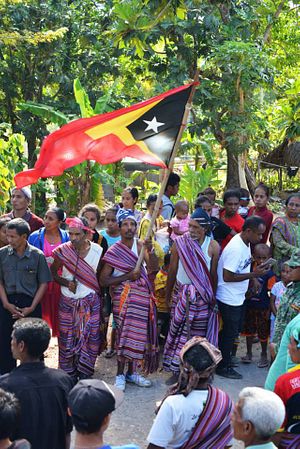This is an election year in Timor-Leste, with the presidential election in March to be followed by the parliamentary elections, scheduled for July 22. Together, these polls will determine the leadership of the country for another five years.
The 2017 presidential election saw yet another former guerrilla fighter, this time Francisco Guterres Lú-Olo, from one of the main parties, the Revolutionary Front for an Independent East Timor (FRETILIN), emerge as the victor.
On July 22, Timorese will once again head to the polls to vote for their new government and National Parliament representatives. Timorese take their civic duty to vote very seriously, with voter turnout in the presidential election at over 70 percent, just slightly lower than in the previous election.
In only 15 years since Timor-Leste’s independence, the small nation has already had seven constitutional governments, one of the great achievements for this new democratic state and for the Southeast Asia region too.
Another sign of the vitality of the democratic state of Timor-Leste is the considerable number of political parties that will dispute the upcoming legislative election.
After the restoration of independence, 13 political parties straightway disputed the first election in the country. Five years later, in 2007, the number of parties increased to 14, and then jumped considerably to 21 in 2012. Again in 2017, 21 political parties will compete in what the Timorese fondly describe as the “Festa Demokrasia” (Party of Democracy) — that is, the election.
But what does this considerable number of political parties disputing elections mean, especially for a country with a population of only 1.2 million and currently with only some 700,000 voters.
For some analysts, the number of parties might be indicative of great division within Timorese society or of wider underlying sociopolitical polarization. What could possibly fuel such analysis is the incessant tit-for-tat bickering among the top echelons of the biggest and most influential parties. These tensions spill over down the ranks, and are further exacerbated by social media users. Thus, it seems, to the untrained eye, that Timorese are always at odds with each other.
Then again, this might just be a matter of optics and perception. In principle, one of the consistent desires of Timorese founding parents, and leaders before independence and after, has always been the maintenance of its democratic values.
Fifteen years on and the Timorese people have demonstrated the true value of democracy; that is, despite polarizing opinions and varied ideological points of view, they are consistently united.
The multiparty system which Timor-Leste adheres to constitutionally welcomes those that seek to govern, establish their own parties, present their programs, and compete during elections, provided that they meet the necessary criteria. Therefore, the considerable increase in party numbers since 2002 might just be a normal process. It is also fair to assume that the current trend is a show of deeper progress in Timorese understanding of their rights and obligations granted by the political system itself, which strongly promotes pluralism.
It is also a sign that Timor-Leste is growing more maturely accustomed to the normal practices of democracy.
Despite the number of names on the ballot, political parties and their leaders actually possess similar (if not the same) programs and rhetoric when it comes to the development of the country. To provide some simple examples, Timorese political parties agree on a number of issues: the national priority of the permanent border demarcation with Australia, maintaining peace and stability, economic diversification, combating corruption, ascension to ASEAN and exposure to the international arena, tackling unemployment, and improving productive sectors such as tourism and agriculture.
It is imperative to emphasize that when it comes to the permanent delimitation of maritime border between Timor-Leste and Australia, there is no such thing as partisanship, division, or disagreement among political parties. As a matter of fact, the recent protest in front of the Australian Embassy in Dili and worldwide protests against the Australian government were participated by Timorese from all the existing political parties in the country. They were unanimously supportive of Timor-Leste’s leaders in bringing the issue of the Timor Sea dispute to the United Nations Conciliation Commission under UNCLOS, led by Timor-Leste’s chief negotiator, Kay Rala Xanana Gusmao.
Also, despite often obvious and harsh verbal sparring matches, none of Timor-Leste’s political leaders have suggested that their followers make an detrimental moves against their political adversaries, let alone advocating for violence. All the parties favor national stability and peace. That is why it is never problematic for the competing political parties to sign a Pact of National Unity in every election, to guarantee peace and harmony among themselves.
Last but not least, Timorese are thoroughly aware that peace is not only the absence of conflict. It must be sustained with development in all critical sectors. Therefore it is also the aspiration of all leaders in Timor-Leste to pursue Goal 16 of the Sustainable Development Goals, which strives to guarantee peace to be able to pave ways for development and vice versa.
These are substantial factors of political agreement which should serve as tangible evidence of Timor-Leste’s unity.
Flavio Simoes is a locally-based political/security observer and a Chevening and Aikameli Trust Scholar. This article represents the views and opinions of the writer only.

































